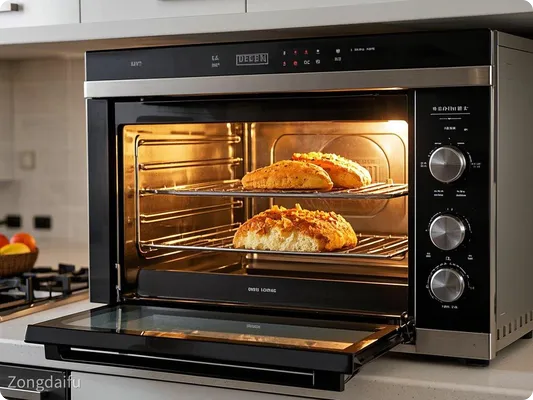On the big stage of global trade, Chinese kitchen appliances have emerged in the international market with high cost-effectiveness, rich and diverse functions and constantly innovative designs, and the scale of exports continues to grow. From January to May 2024, China's exports of home appliances to the North American market have rebounded, with exports to the United States reaching US$9.38 billion, a slight increase of 3.2% year-on-year. Among them, the demand for small kitchen appliances has gradually recovered, and most products have performed well in exports.
The family structure and lifestyle of the United States determine its high demand for kitchen appliances. American families generally own independent houses, which provides convenient conditions for the use of various kitchen appliances. In addition, Americans are keen on cooking and holding family gatherings, and have high requirements for the functionality and diversity of kitchen appliances.

Next, this article will focus on Chinese kitchen appliancesExport to the United StatesWe conduct detailed analysis to help you understand every link from product production, transportation to sales, familiarize yourself with various US regulatory certification standards, and ensure that your products can enter the US market smoothly.
Specific process
- Market research and customer development: Find American customers by participating in international exhibitions, using e-commerce platforms, entrusting overseas agents, etc., and understand the demand characteristics, consumption habits, and popular trends of the American market for kitchen appliances.
- Order negotiation and signing: Negotiate with American customers on product specifications, quantity, price, delivery date, payment method and other terms, and sign a formal export contract after reaching an agreement.
- Production and Inspection: Organize production according to contract requirements to ensure that product quality meets U.S. regulations and standards. After production is completed, conduct strict self-inspection or entrust a third-party inspection agency to conduct inspection.
- Certification processing: According to the product type and relevant US regulations, necessary certifications such as FCC certification, UL certification, etc. are processed.
- Packaging and labeling: Package the product in accordance with the packaging and labeling requirements of the United States, and mark the necessary information on the product and packaging.
- Transportation and customs declaration: Choose the appropriate mode of transportation, such as sea transportation, air transportation, etc. Prepare the commercial invoice, packing list, customs declaration, bill of lading, copy of the contract, inspection documents and other documents, and declare the export to the Chinese customs.
- Customs clearance and delivery: After the goods arrive at the US port, the US customer or its agent will go through customs clearance procedures with the US Customs with relevant documents, and the goods will be delivered to the customer after customs clearance is completed.

Regulatory and certification requirements
Security certification
- UL certification: UL is one of the most authoritative non-governmental organizations engaged in safety testing and appraisal in the United States. Its certification standards have a wide influence worldwide. UL certification mainly focuses on the safety performance of products, covering electrical safety, mechanical safety, fire protection, chemical safety and other aspects.
- ETL certification: ETL certification is also a well-known and recognized safety certification mark in North America. Products with the ETL mark meet the mandatory standards of North America and can be sold smoothly in the North American market. ETL certification requires factory inspection before issuance, and follow-up factory inspections will be conducted irregularly every quarter to ensure that products always meet relevant standards.
Electromagnetic compatibility certification
- FCC certification: FCC certification applies to all types of electronic equipment sold in the U.S. market, including but not limited to radio transmission equipment, communication equipment, computers and their peripheral equipment,Home appliancesFor kitchen appliances, FCC certification plays a vital role. It ensures that the appliances will not generate electromagnetic interference to surrounding electronic devices when they are working normally, and it also ensures that they are not interfered with by other devices, thereby ensuring the normal operation and safe use of the products.
Energy efficiency certification
- US Energy Star certification: a voluntary energy conservation program jointly promoted by the US Environmental Protection Agency (EPA) and the US Department of Energy (DOE). This certification has strict requirements on the energy efficiency of products, covering multiple fields such as electronic products, home appliances, and lighting equipment. For kitchen appliances, obtaining Energy Star certification means that the product has reached a high standard in terms of energy utilization, which can effectively reduce energy consumption and reduce the user's cost of use.
Food contact material certification
- FDA certification: This certification has extremely strict safety requirements for food contact materials. Take the rice cooker as an example. The inner pot, sealing ring, steam valve and other parts of the rice cooker will directly contact food during use. Therefore, the materials used in these parts must comply with the relevant FDA standards to ensure that the product will not release harmful substances when in contact with food, and will not cause harm to human health.

Packaging labeling requirements
- Basic information: The product packaging should clearly indicate basic information such as product name, model, specifications, quantity, production date, shelf life, as well as the name, address, contact information, etc. of the manufacturer or distributor.
- Certification mark: If the product has passed FCC, UL, FDA and other certifications, the corresponding certification mark and certification number must be correctly marked on the product and packaging.
- Warnings and instructions: There must be warnings in English to remind users of possible risks and precautions during use, such as preventing scalding and electric shock, etc. There must also be detailed instructions in English, including the product's functions, operating methods, maintenance methods, etc.
- Country of origin label: "Made in China" must be clearly marked to indicate the product's country of origin.
Common problems and solutions
- Certification difficulties: Since the certification standards are numerous and complex, involving multiple fields such as safety, electromagnetic compatibility, energy efficiency, and food contact materials, companies may misunderstand or miss key information if they are not careful, resulting in delays or failures in certification applications. To solve these problems, companies should actively seek help from professional certification agencies to obtain accurate certification guidance and consulting services. Before certification, companies should conduct comprehensive self-inspection and pre-testing of products to promptly identify and resolve potential problems.
- Changes in trade policies: The dynamic changes in US trade policies, tariff adjustments, trade barriers and other factors have brought many uncertainties to China's kitchen appliance exports. In this regard, companies can reduce costs by optimizing the supply chain. At the same time, they can actively expand other international markets, reduce dependence on a single market, and disperse trade risks. Companies can also strengthen communication and cooperation with industry associations and government departments, keep abreast of changes in trade policies, and jointly respond to trade challenges.
- Logistics risk: In the logistics process, transportation delay is one of the common risks. Bad weather conditions, traffic congestion, poor connection of logistics links, etc. may cause the goods to fail to arrive at the destination on time. The damage of goods during transportation should not be ignored. In this regard, enterprises should choose logistics partners with good reputation and reliable services; strengthen the packaging and protection measures of goods; purchase freight insurance and other ways to reduce corporate losses.
Conclusion
We hope that the majority of kitchen appliance related companies can fully understand the product export process and regulatory certification requirements, bravely take the step to enter the US market, and achieve the international development goals of the company. Finally, if you have other questions or need our further support, please contact us!


 Follow customer service WeChat
Follow customer service WeChat